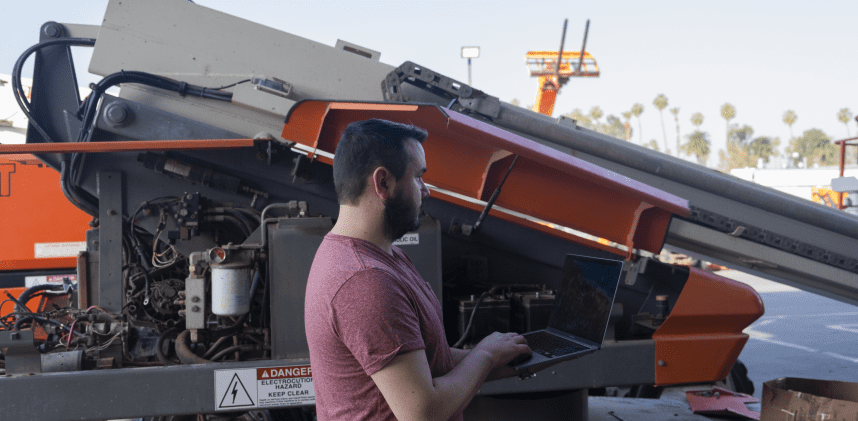

Every day, there is an increasing demand for building new developments in cities and towns. Construction companies have more on their plates and need a way to optimize their internal operations to increase productivity and lower costs.
Optimizing the industry means executing new strategies to manage construction and off-road fleet vehicles. Because of this, fleet management software has become a rapidly growing industry, valued at over $20 billion and projected to continue growing.
As construction companies shift away from slower, manual operations, many are implementing fleet management software to keep up with the demands of a growing industry.
This is where telematics comes in.
Telematics is the crux of optimized fleet management software. The combination of informatics and telecommunications creates a smooth workflow, enabling companies to manage fuel consumption, track fleet location, monitor maintenance schedules, and analyze data reports through one centralized, easy-to-use platform.
Let’s discuss four cornerstone elements of optimized fleet management using telematics.
Enhancing your fleet management begins with a secure and safe workforce. Don’t rely on poor communication and leave accidents unaddressed on the job site. Instead, bring job site safety to the forefront of your business and easily connect and monitor operator performance and safety through one platform.
Use a fleet management system that incorporates regular checks and inspections to ensure off-road fleet vehicles are ready to operate efficiently and safely.
With a few clicks, fleet operators can use centralized communication to inspect, flag, and report any issues, shutdowns, and delays.
Monitoring vehicles, operator usage, and the job site through software allows fleet managers to respond quickly, preventing accidents/breakdowns and minimizing downtime. With comprehensive fleet management software, teams can improve connectivity across the equipment and workers.
Telematics fleet management software often includes GPS-tracking features so fleet managers know where their equipment is at all times.
GPS features allow managers to create geofences around designated areas and zones – rental depots or construction job sites, for example. Once equipment passes the boundaries of these zones – whether entering or exiting – managers get instant notifications alerting them of new activity.
This enhances fleet security, safeguarding companies against theft and unauthorized usage of their assets.
Fuel management is necessary for construction companies to save on costs and reduce their environmental impact.
With Environmental, Social, and Governance (ESG) practices being top of mind for many companies in 2023, it is more important than ever to reduce CO2 emissions — saving money for construction sites and contributing to a healthier planet. Construction companies in America alone are estimated to waste billions of gallons of fuel each year.
Reducing idle time is one of the top ways to decrease emissions, resulting in lower costs for your company. Through the assistance of telematics technology, fleet managers can use software to gain insights into construction vehicle fuel performance and productivity, all through one centralized app.
They can make data-driven decisions about the fleet to save on fuel and CO2 emissions by monitoring idle time and optimizing the use of assets. Real-time data helps fleet managers understand what machines are over- and under-utilized. This feature reallocates and reassigns fleets to other job sites without missing a beat.
By understanding fuel consumption patterns in real-time, fleet managers can train drivers on best practices and fuel-saving techniques to maximize fuel usage and savings.
Prevent costly maintenance and job site delays with real-time engine diagnostics and maintenance notifications. Telematics-based software allows fleet managers to get comprehensive insights into the status of their vehicles.
Instead of reactive measures once vehicles break down a proactive approach reduces downtime by attending to the needs of vehicles before there’s an issue.
Last-minute repairs get expensive. Access to real-time alerts through a telematics system benefits fleet managers by keeping them in the know. Alerts for engine fault codes, fuel usage, and maintenance schedules help fleet managers plan for the best and be prepared for the worst.
It’s the machine equivalent to eating well and getting regular checkups on things like your blood pressure to ensure everything is working as it should; issues get detected early and nipped in the bud before problems become worse.
Optimize and improve your fleet management by accessing information on your off-road fleet vehicle. Telematics provides information on engine performance, fleet location, and maintenance schedules on one centralized platform. Insights on these metrics are crucial in optimizing daily operations and addressing issues as they occur.
Knowing the operations of any given fleet —regardless of the size — keeps everyone informed and helps managers make decisions that do not compromise safety or workflows.
The most valuable thing telematics provides is the high volume of data, which fleet managers can use to improve future decisions and make better use of their assets. Data is key for understanding where a vehicle is, how it is performing, its maintenance schedule, fuel consumption, and idle time.
Real-time data allows construction companies to get ahead of operations and make informed decisions that promote efficiency and cost savings. For example, rental businesses can take note of which vehicles are the most profitable based on their demand and usage. From this, they know which equipment to invest in for future success and growth.
With data analysis, construction fleet managers can manage resources on each site effectively and efficiently. This enables them to make the best use of their equipment, avoid downtime and improve productivity.
Better productivity means faster turnaround times, happier customers and more business.
Effective fleet management software starts and ends with telematics.
Telematics instills confidence in operations, allowing fleet managers to know about their location, driver behavior, maintenance schedules, and data tracking, all important for making informed decisions about daily and future operations.
By managing your fleet in one easy-to-use system, your company can increase productivity and save costs today and in the long run. Book a demo with Trackunit today and experience better fleet management.

Never miss an insight. We’ll email you when new articles are published on this topic.

